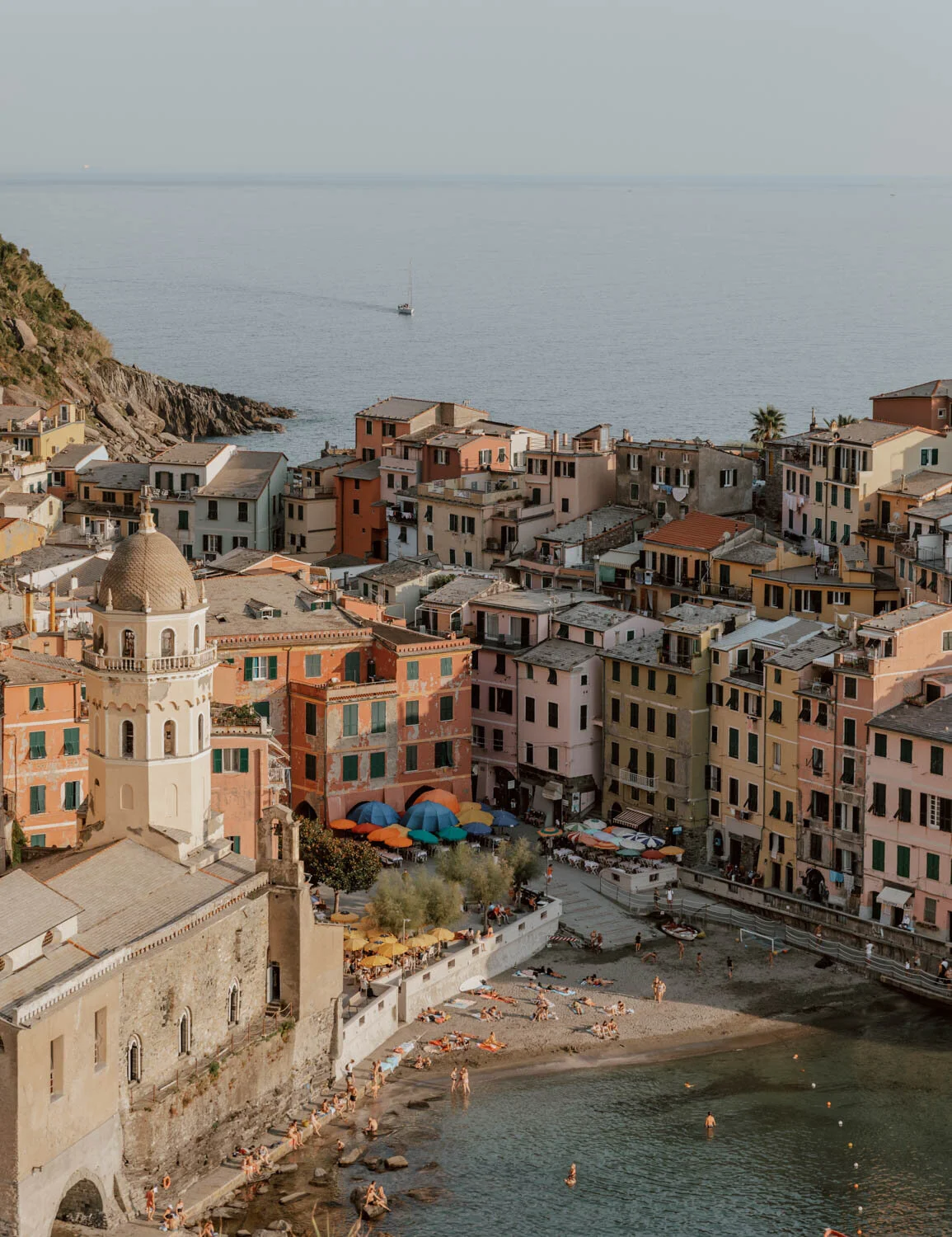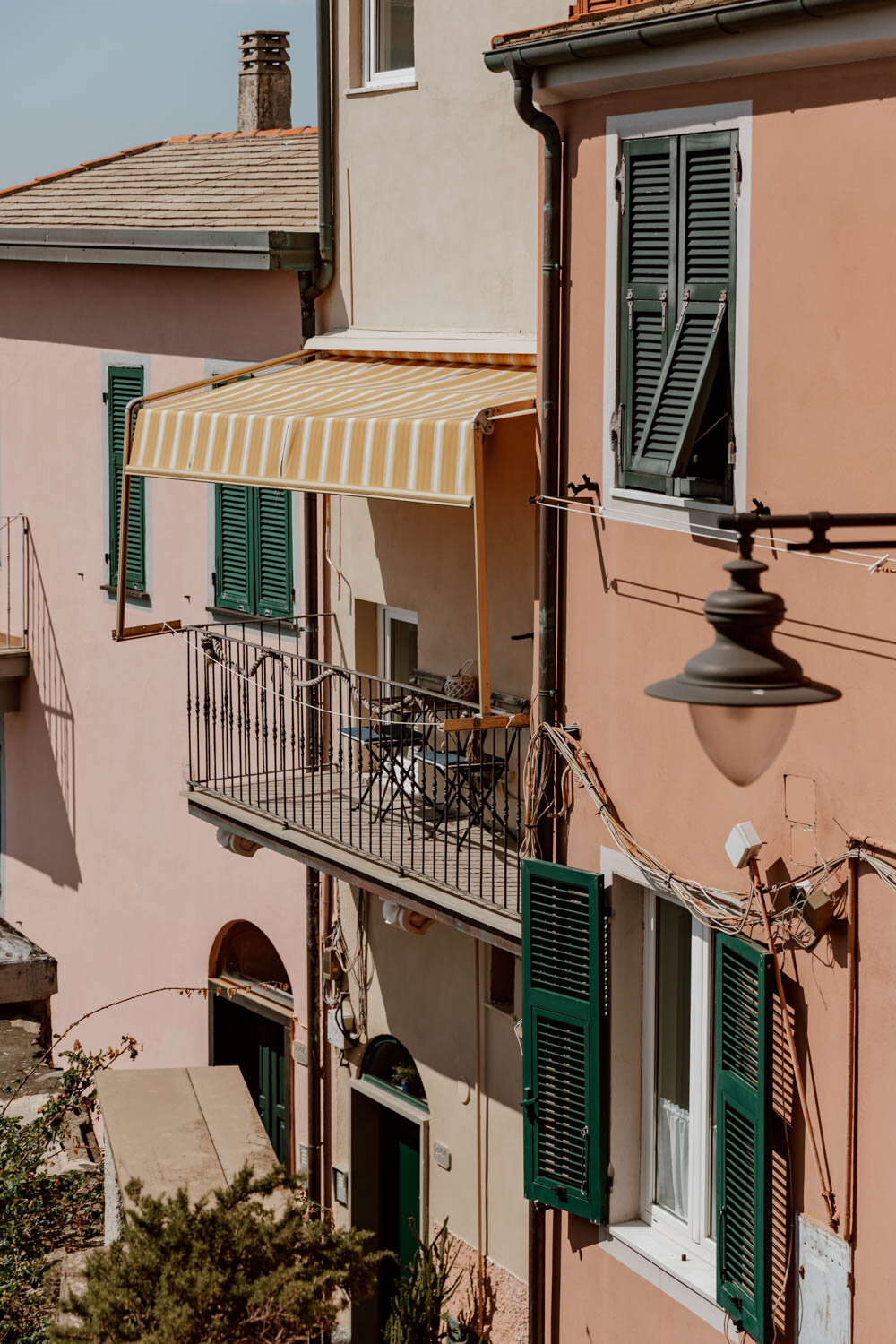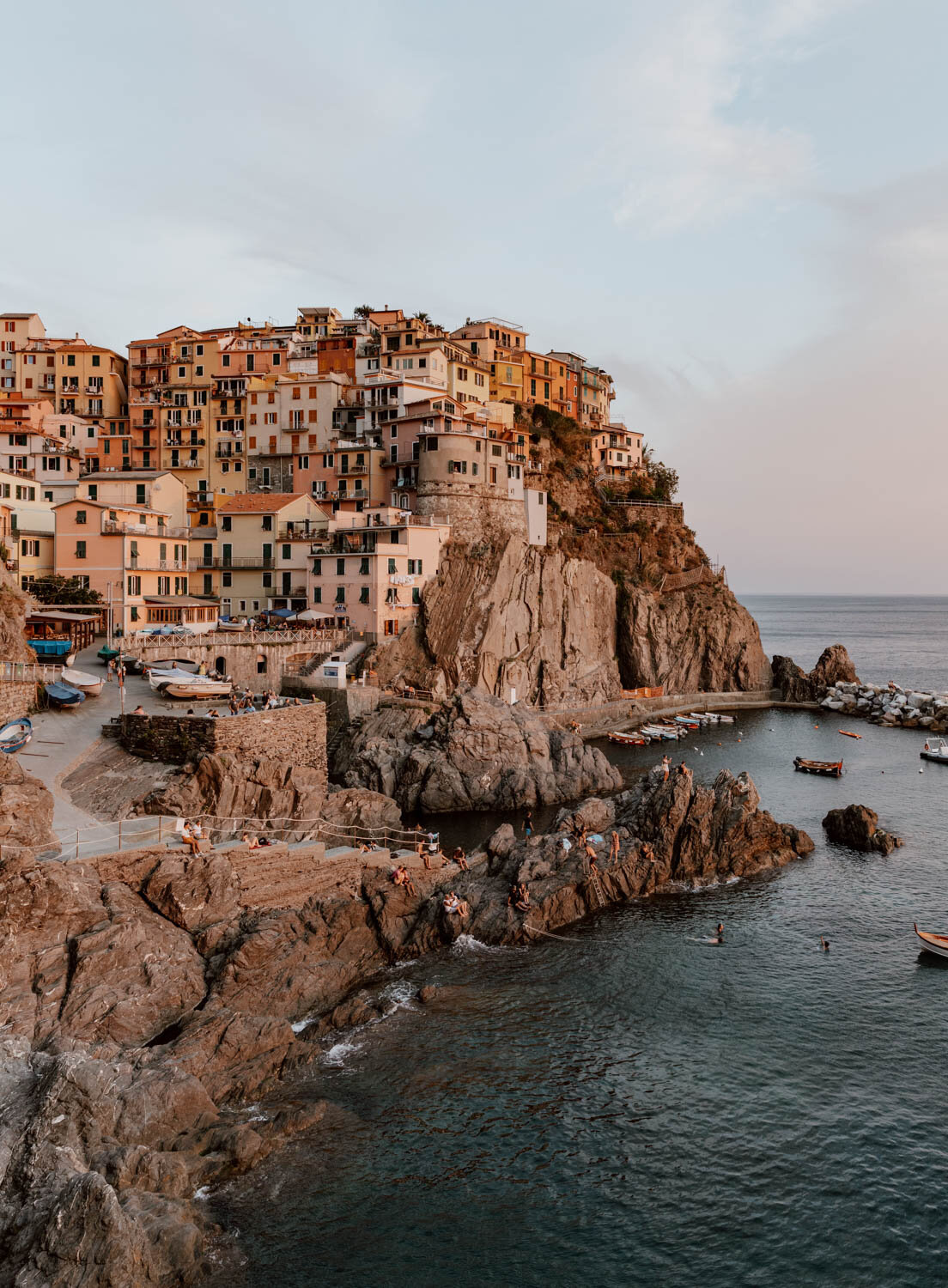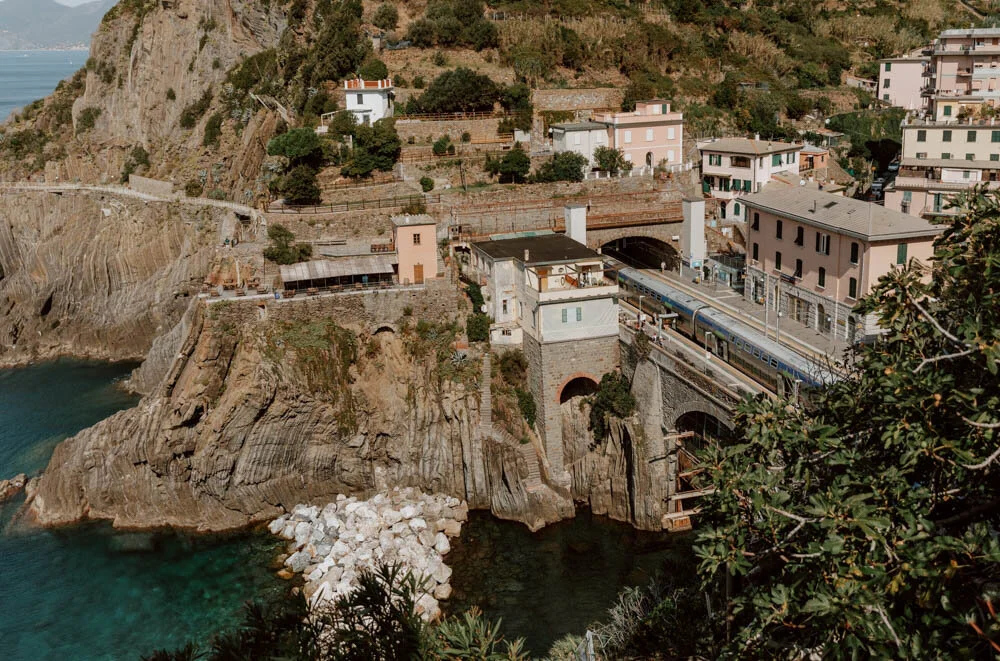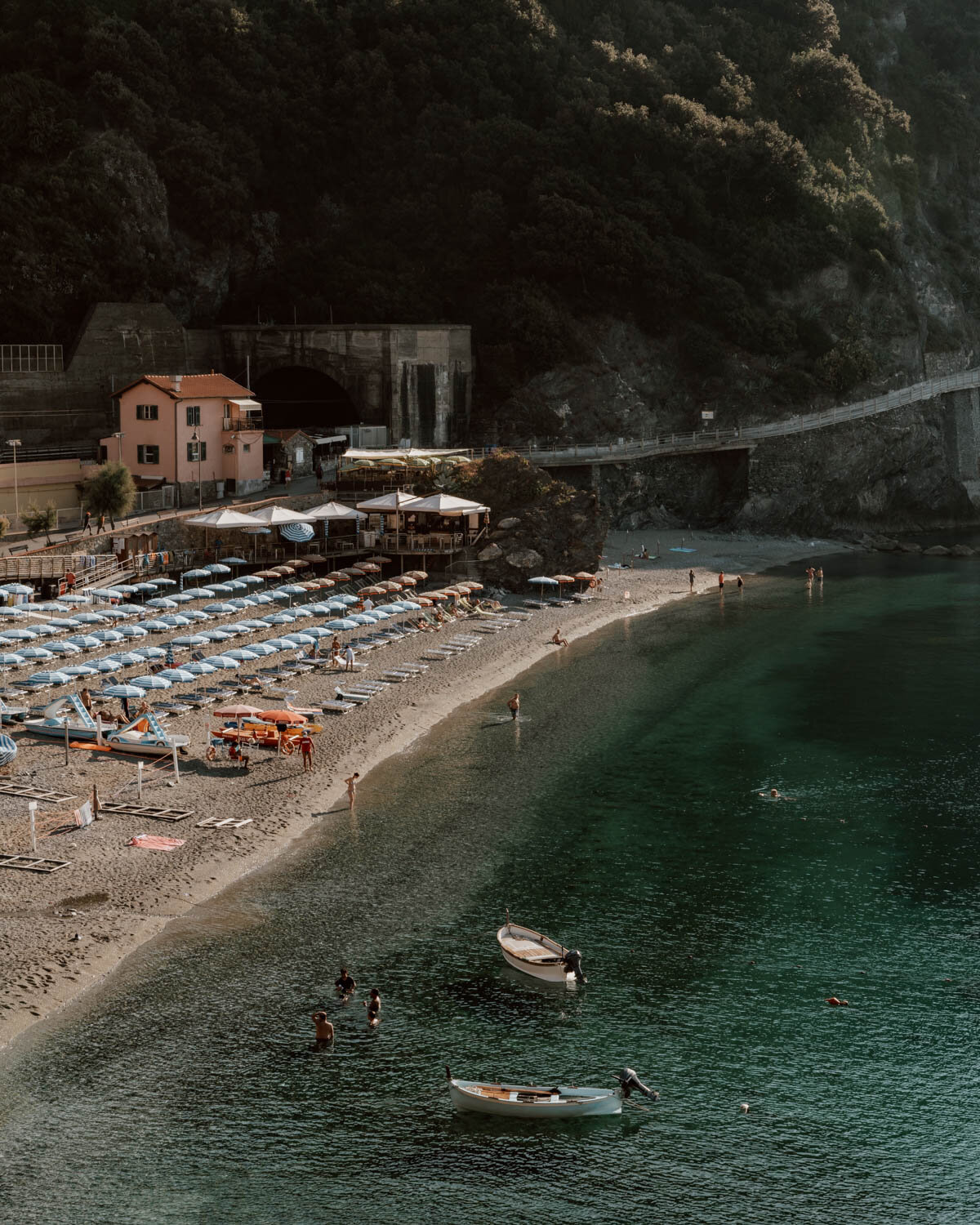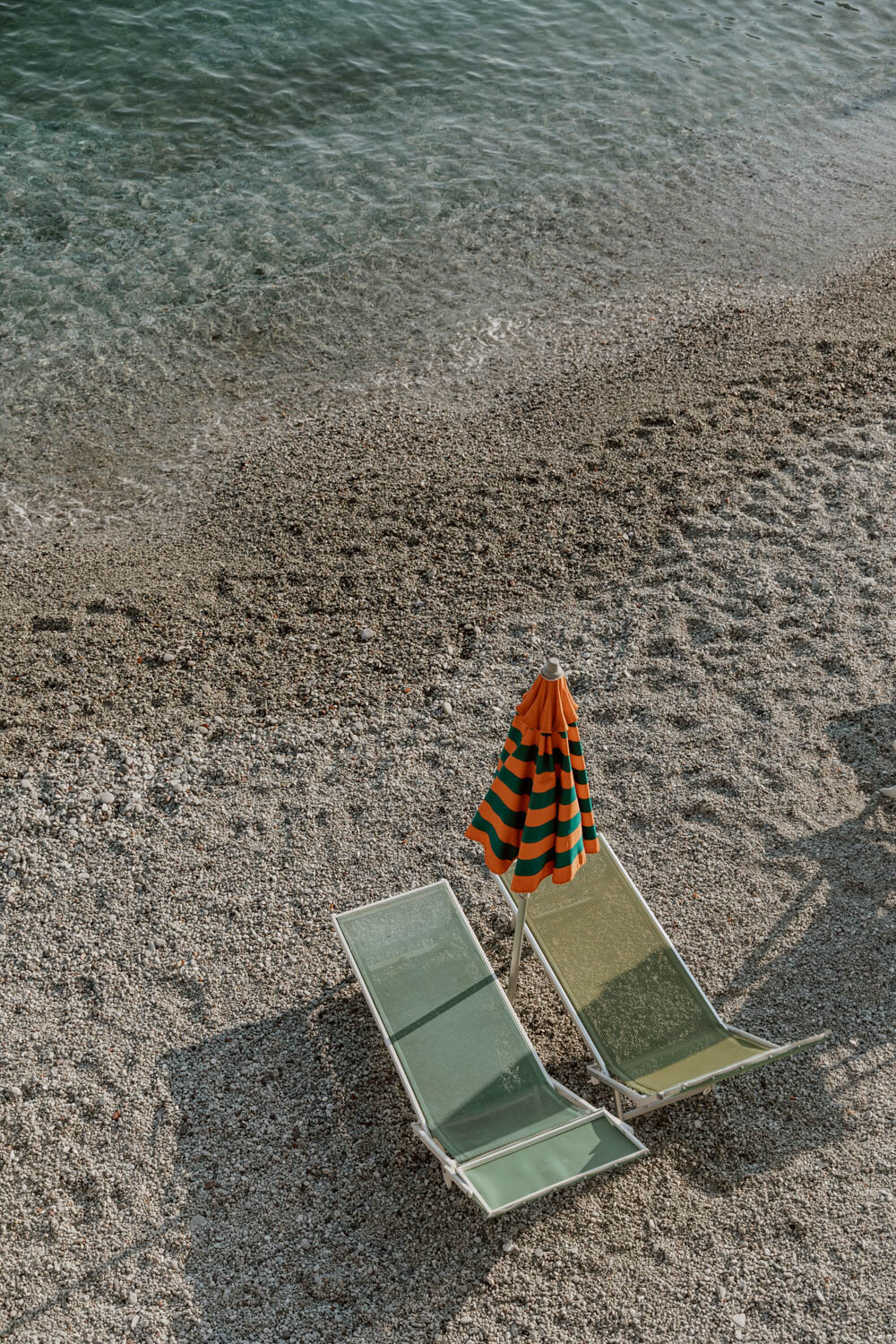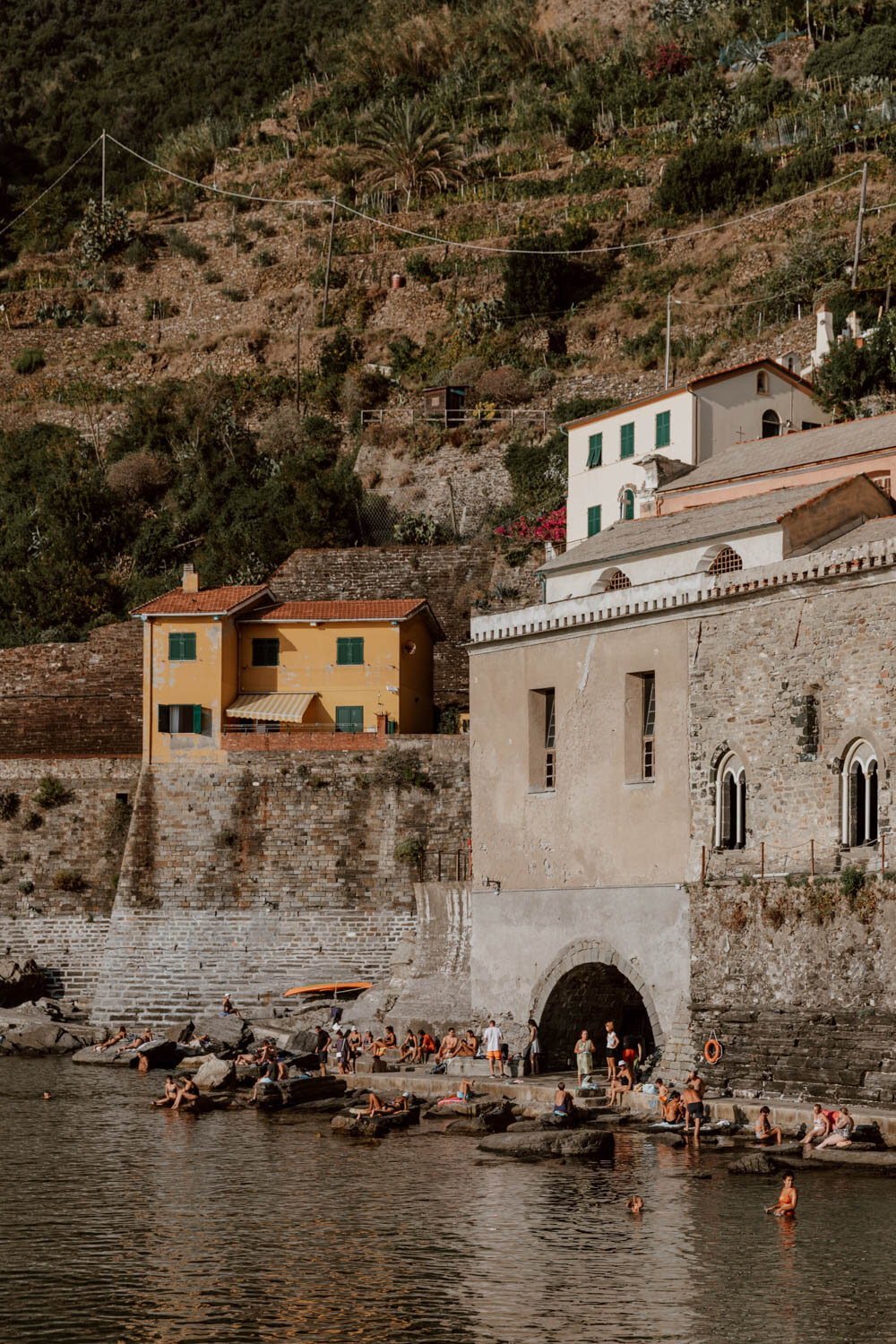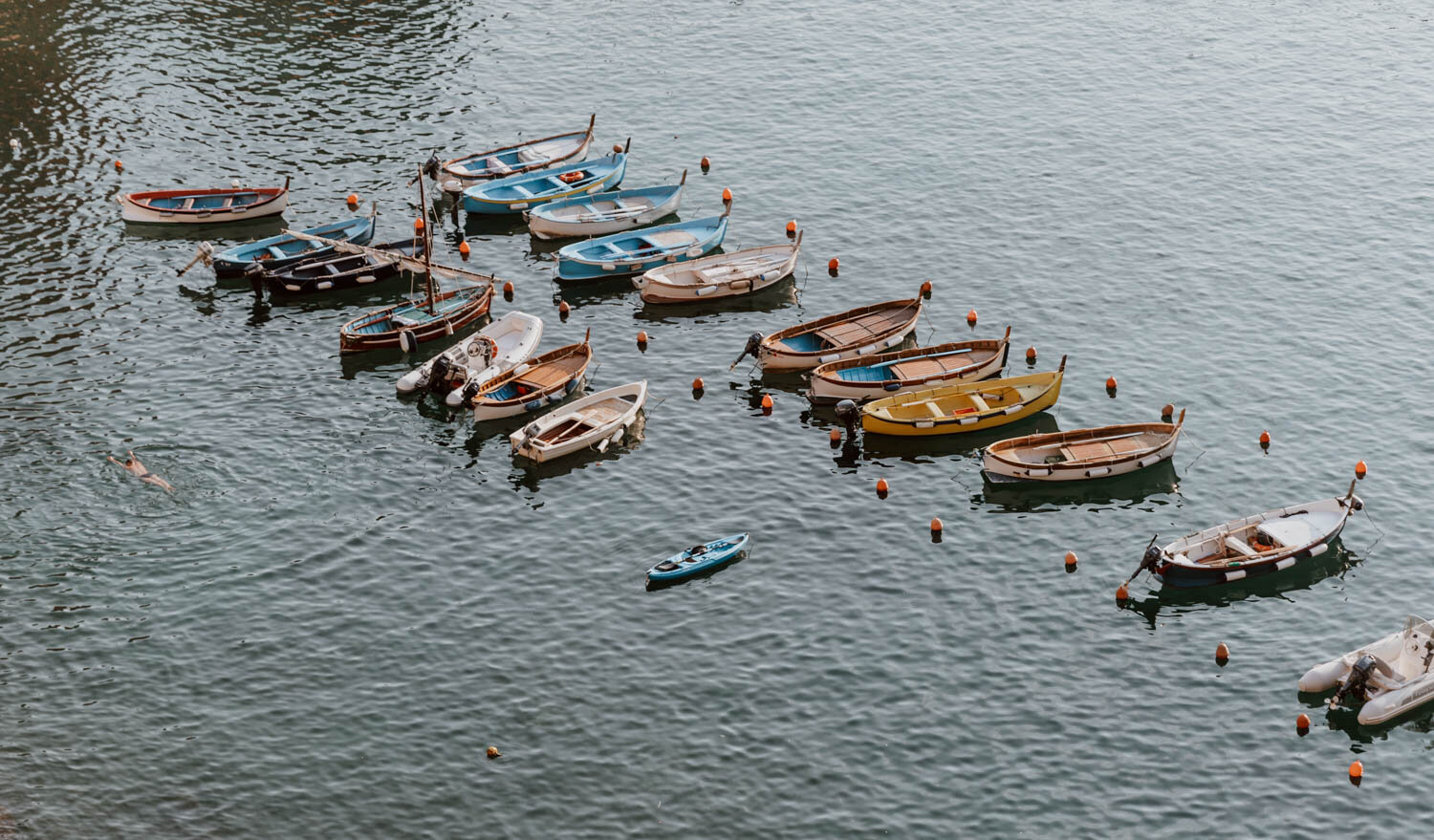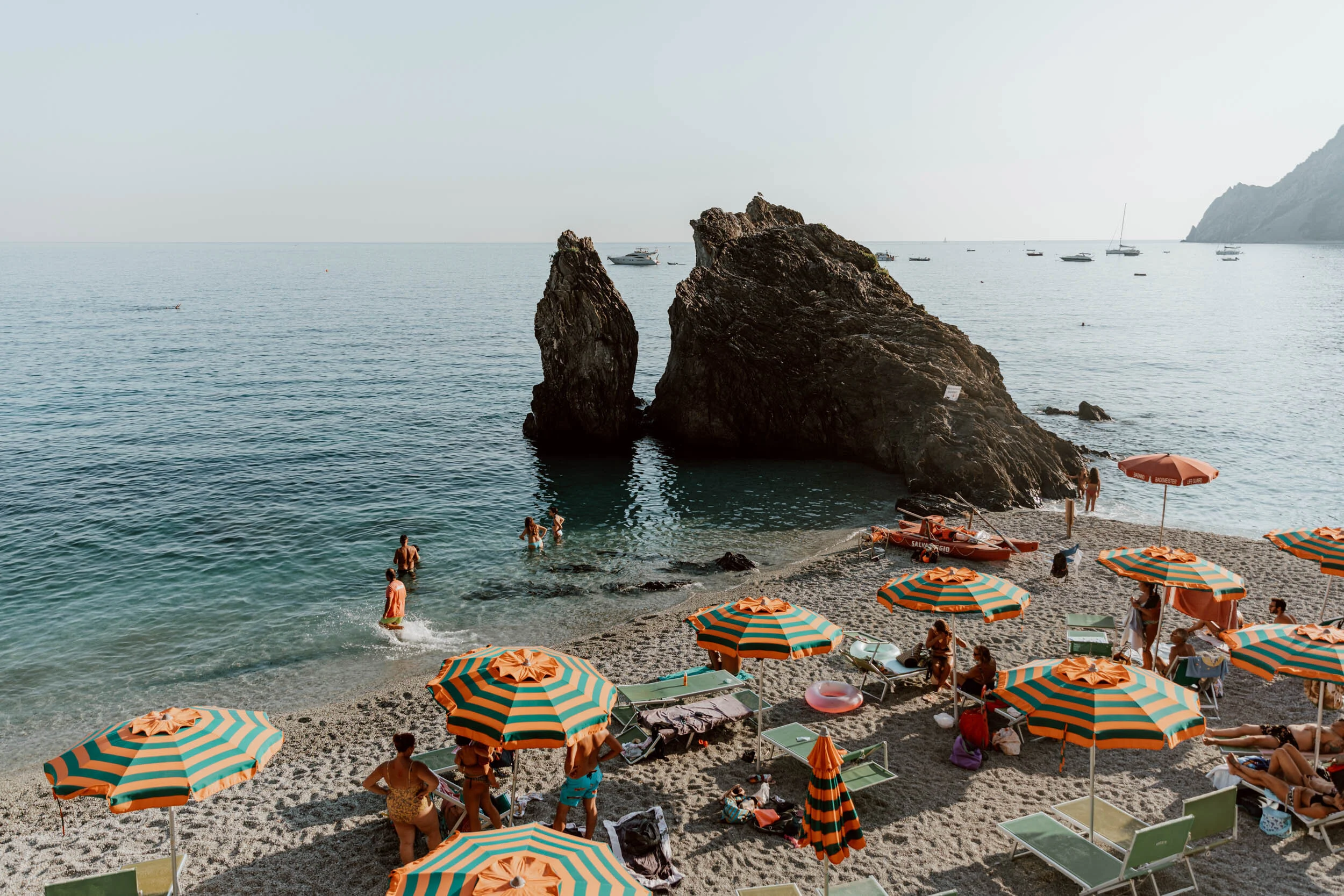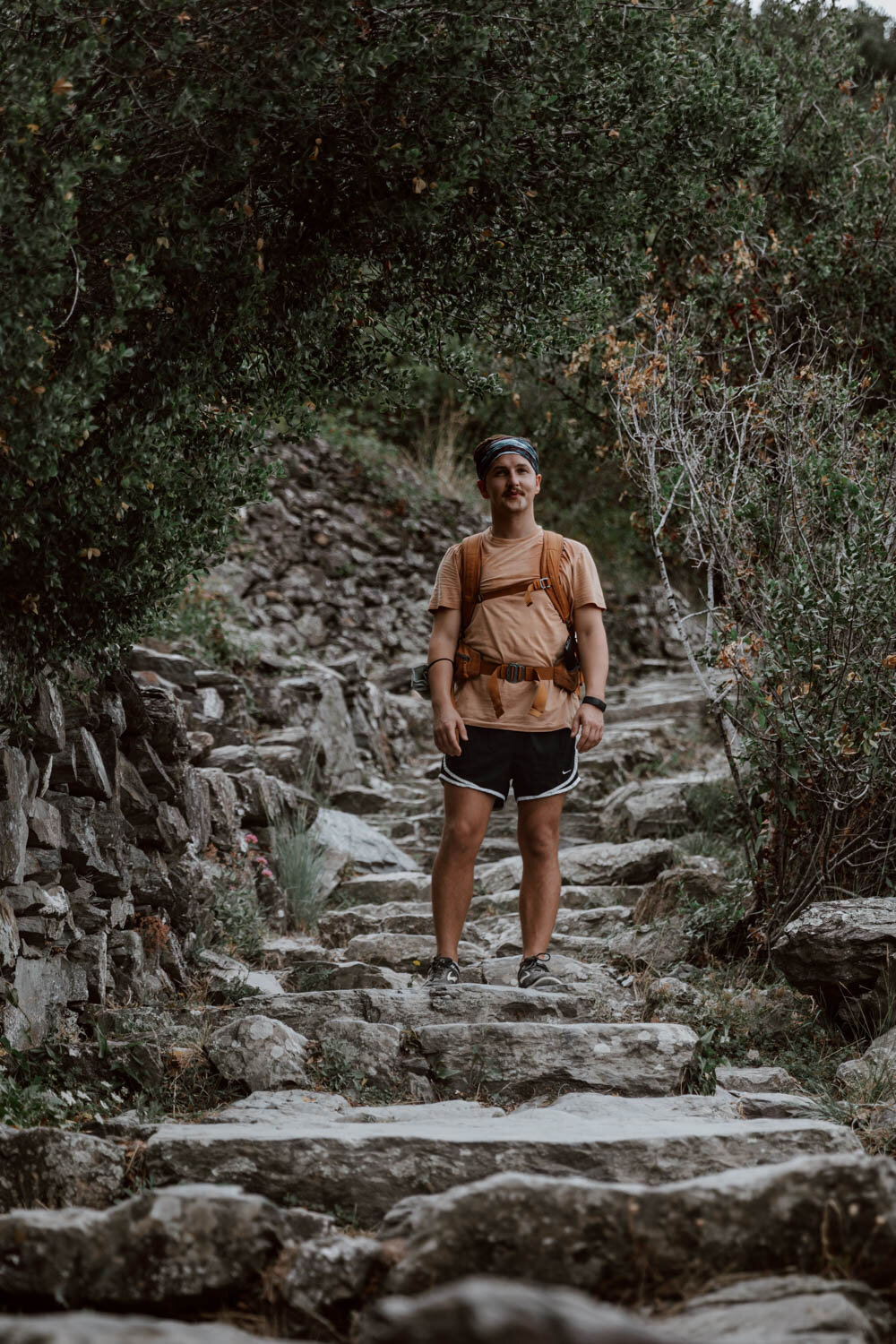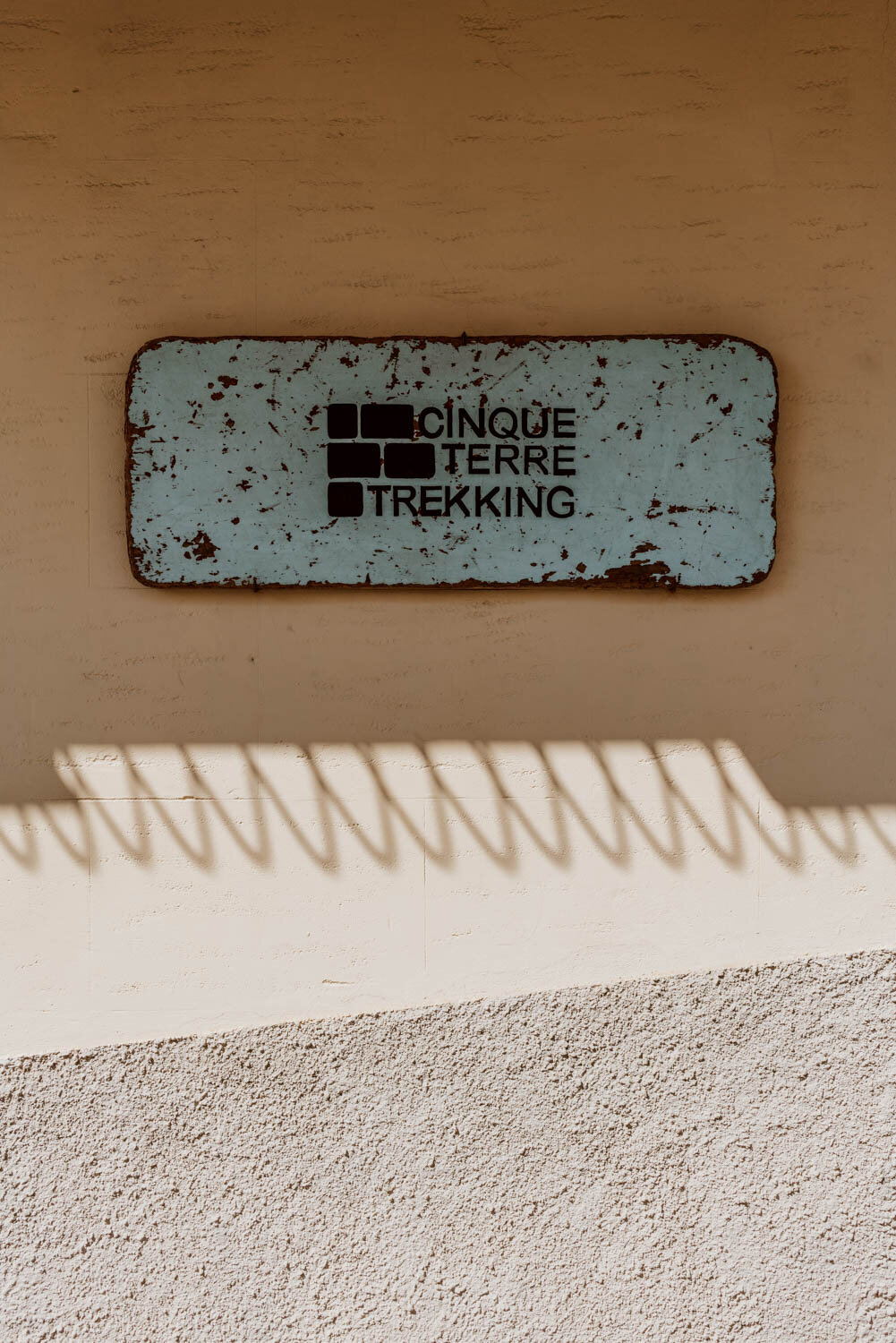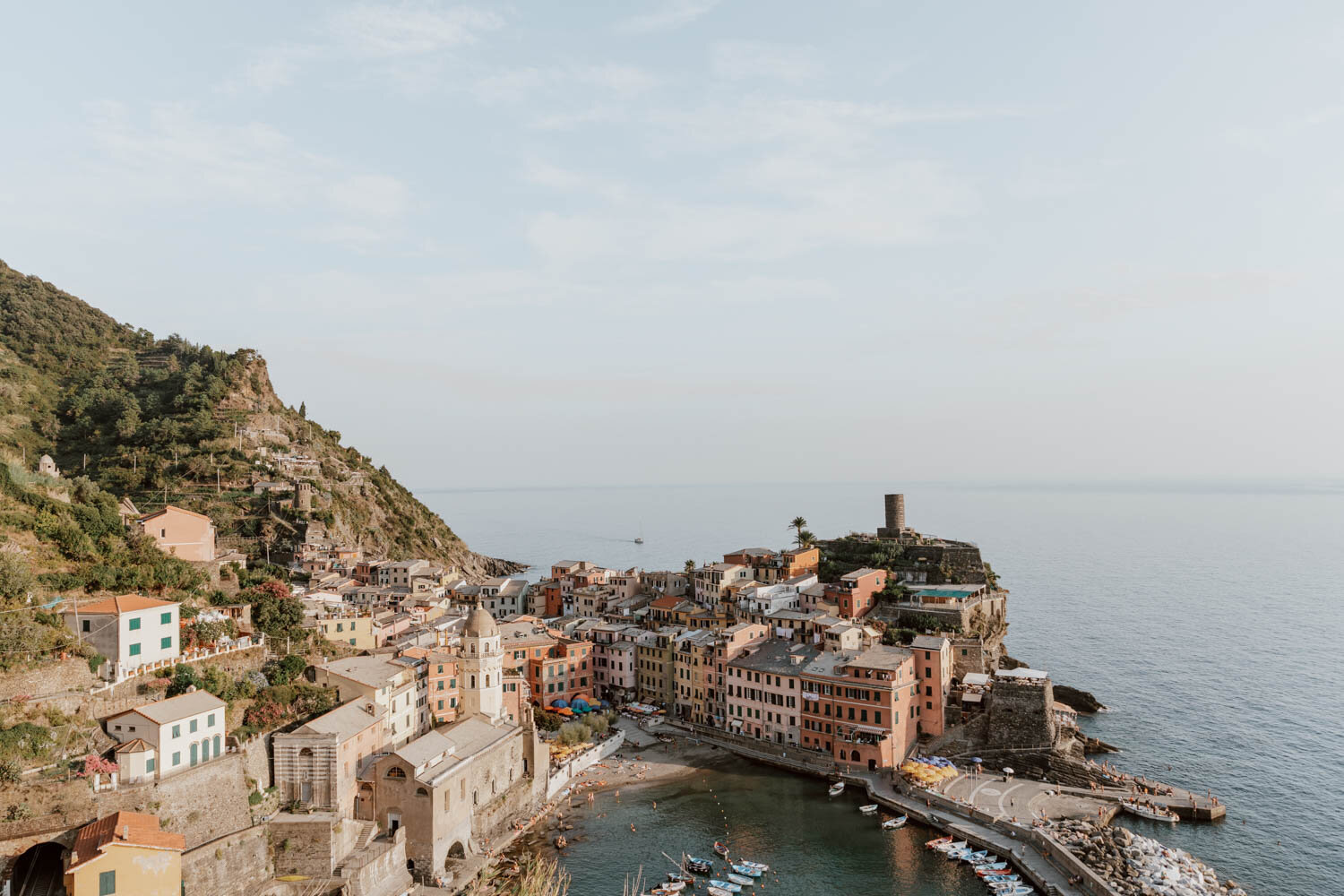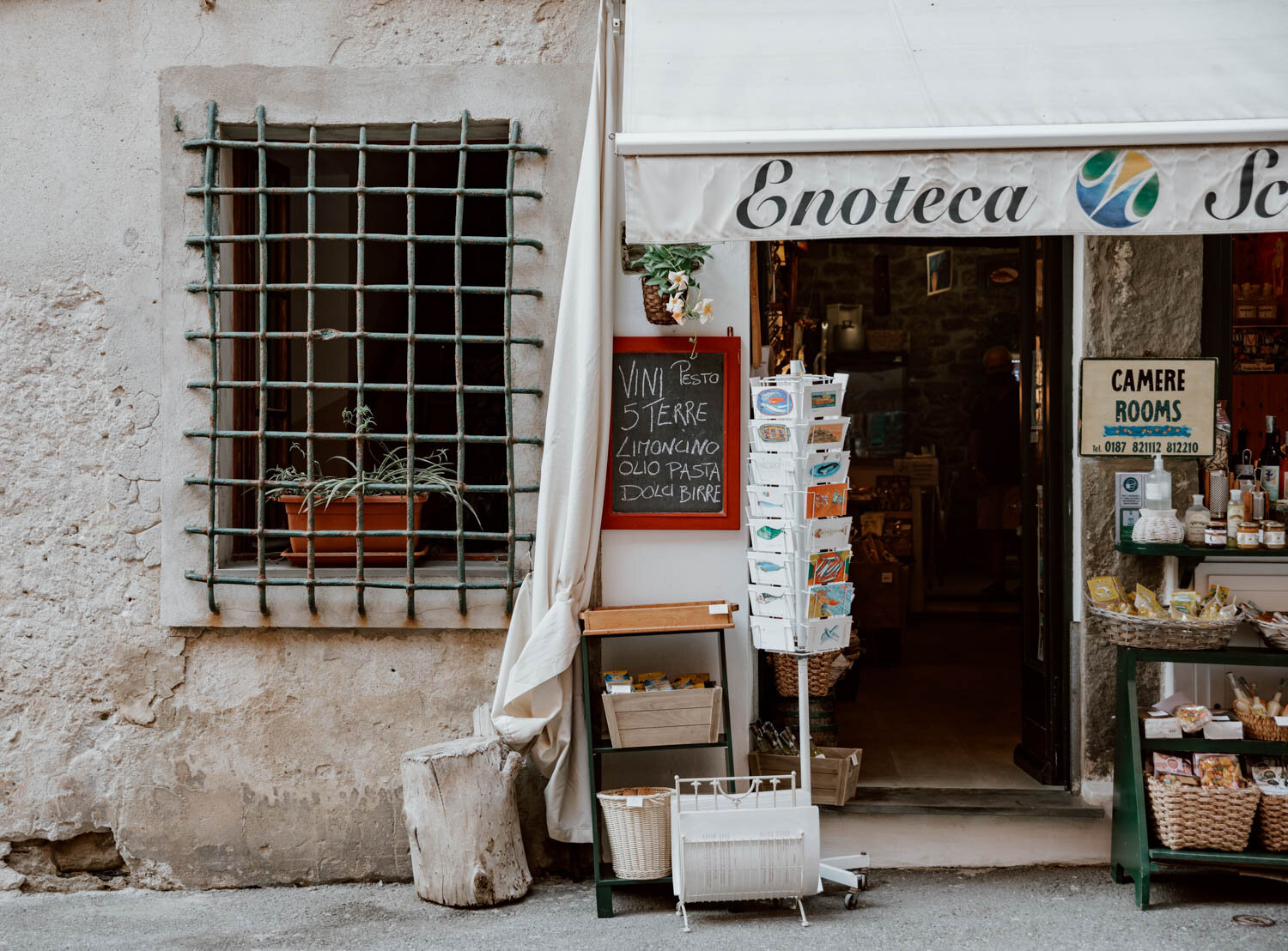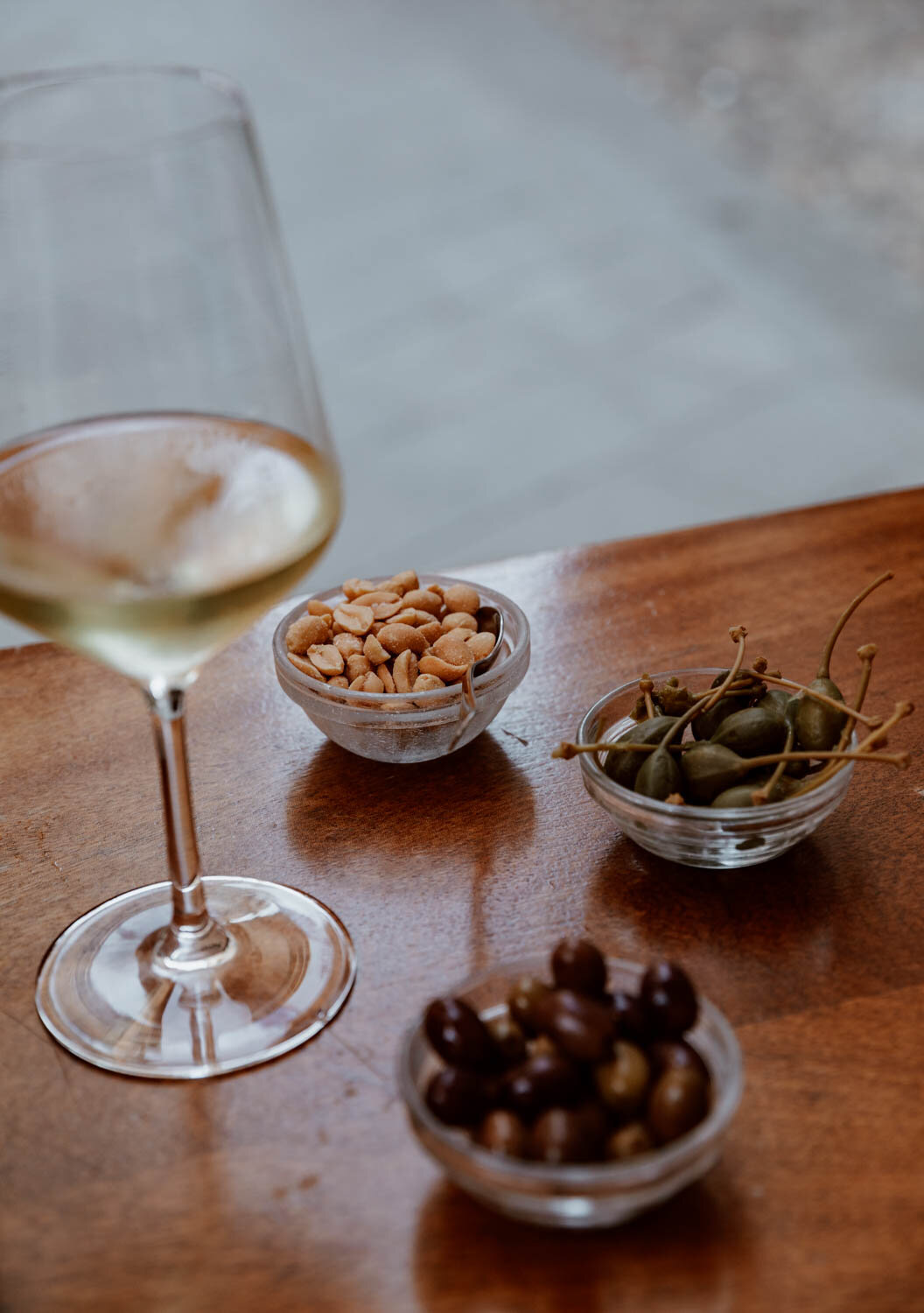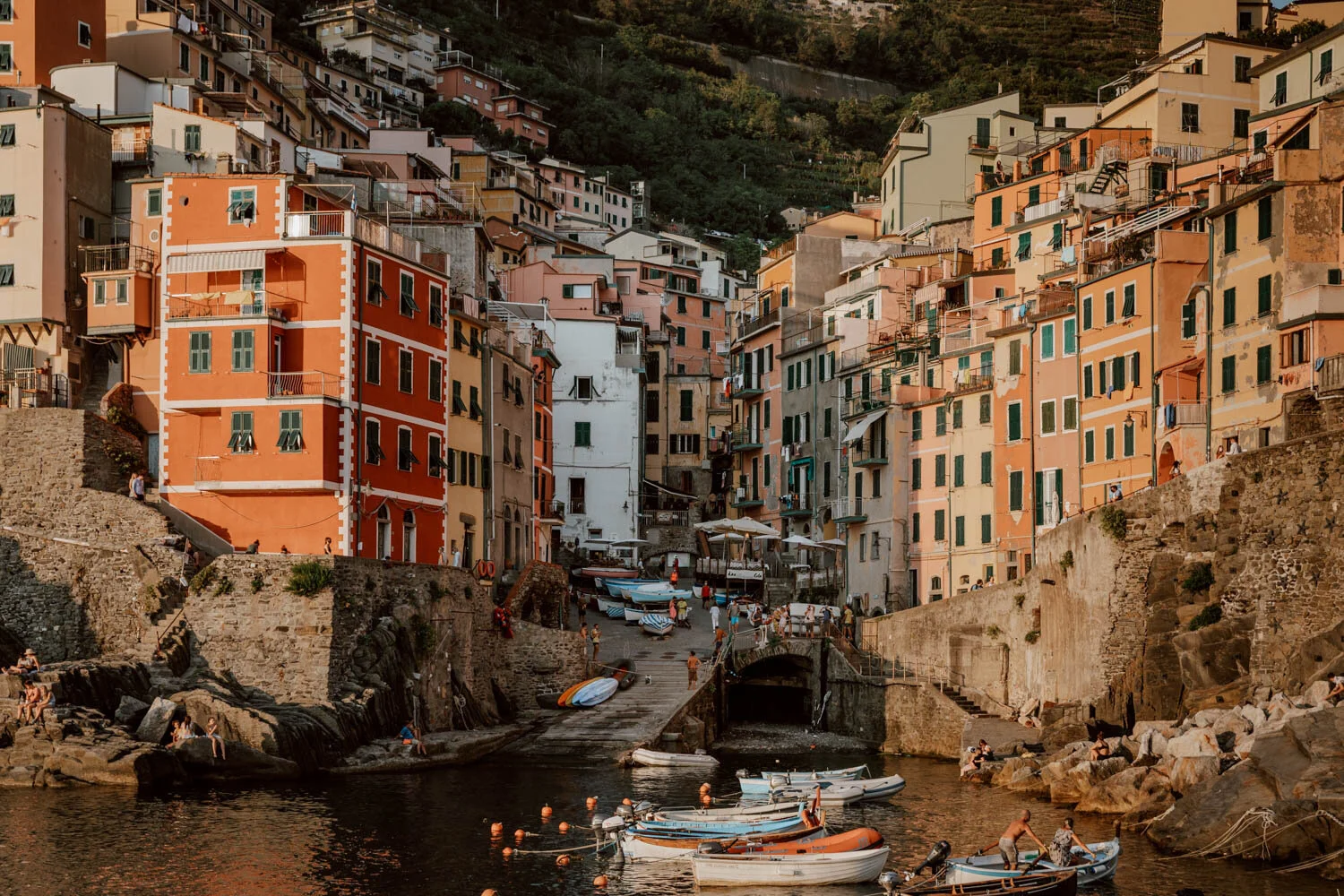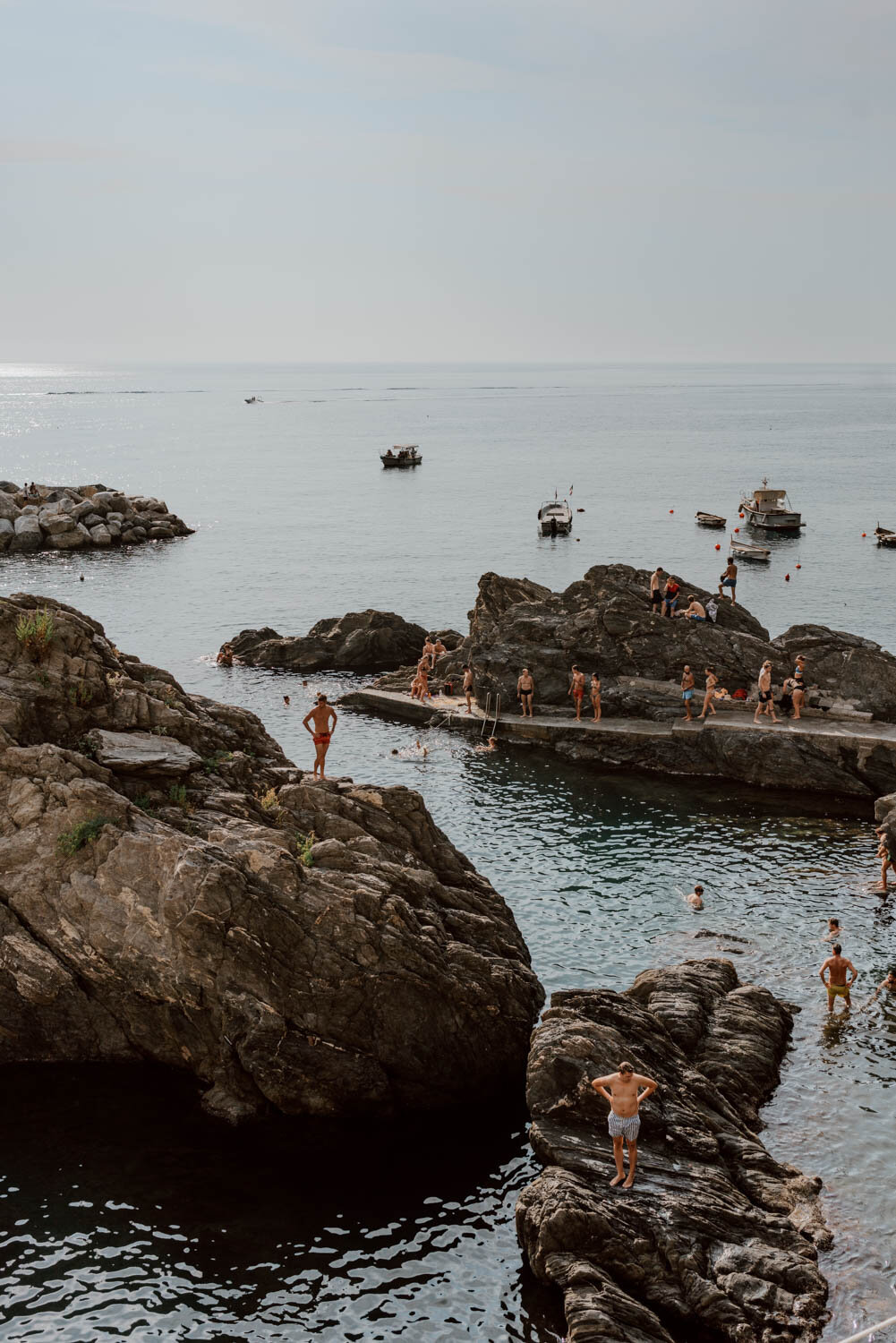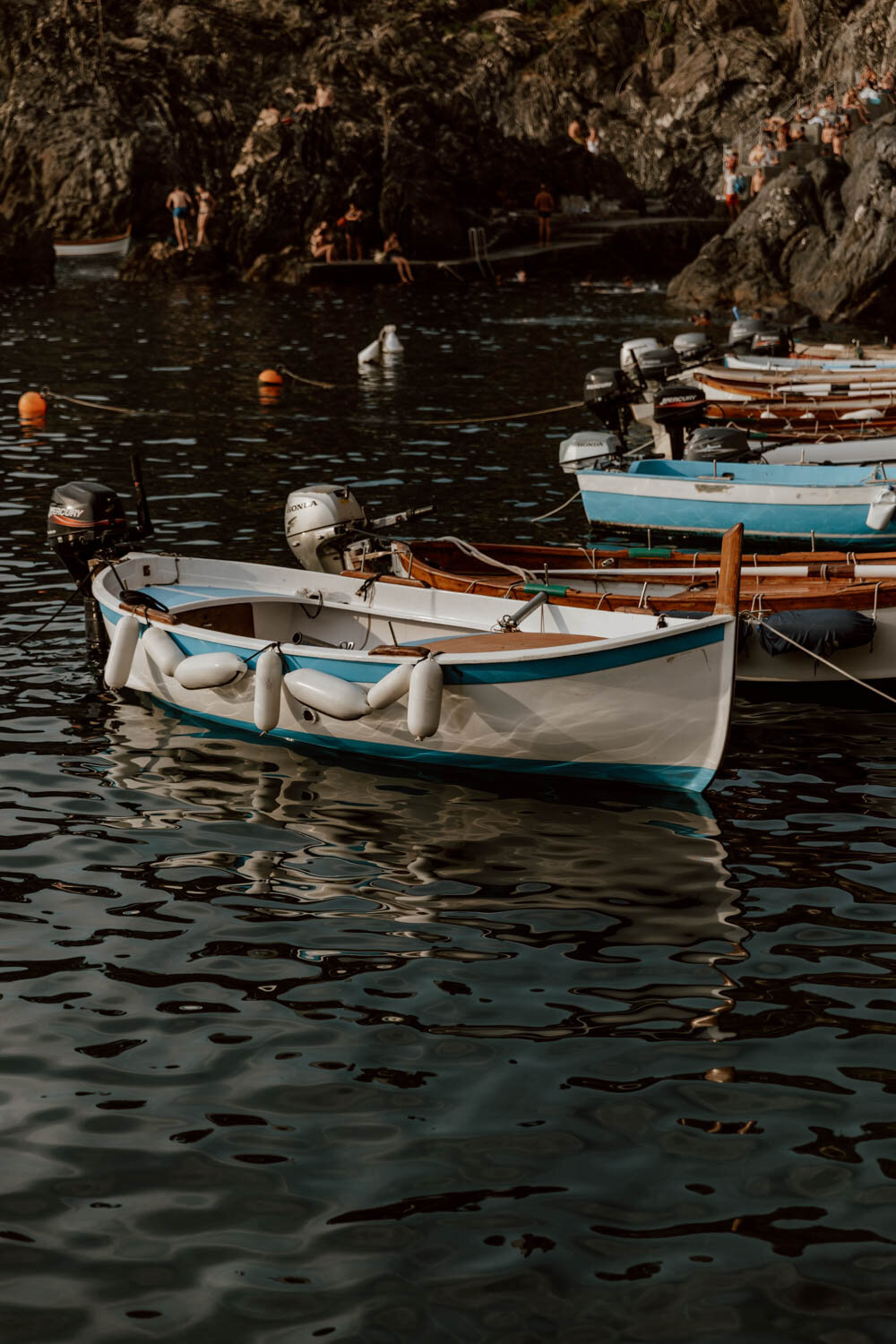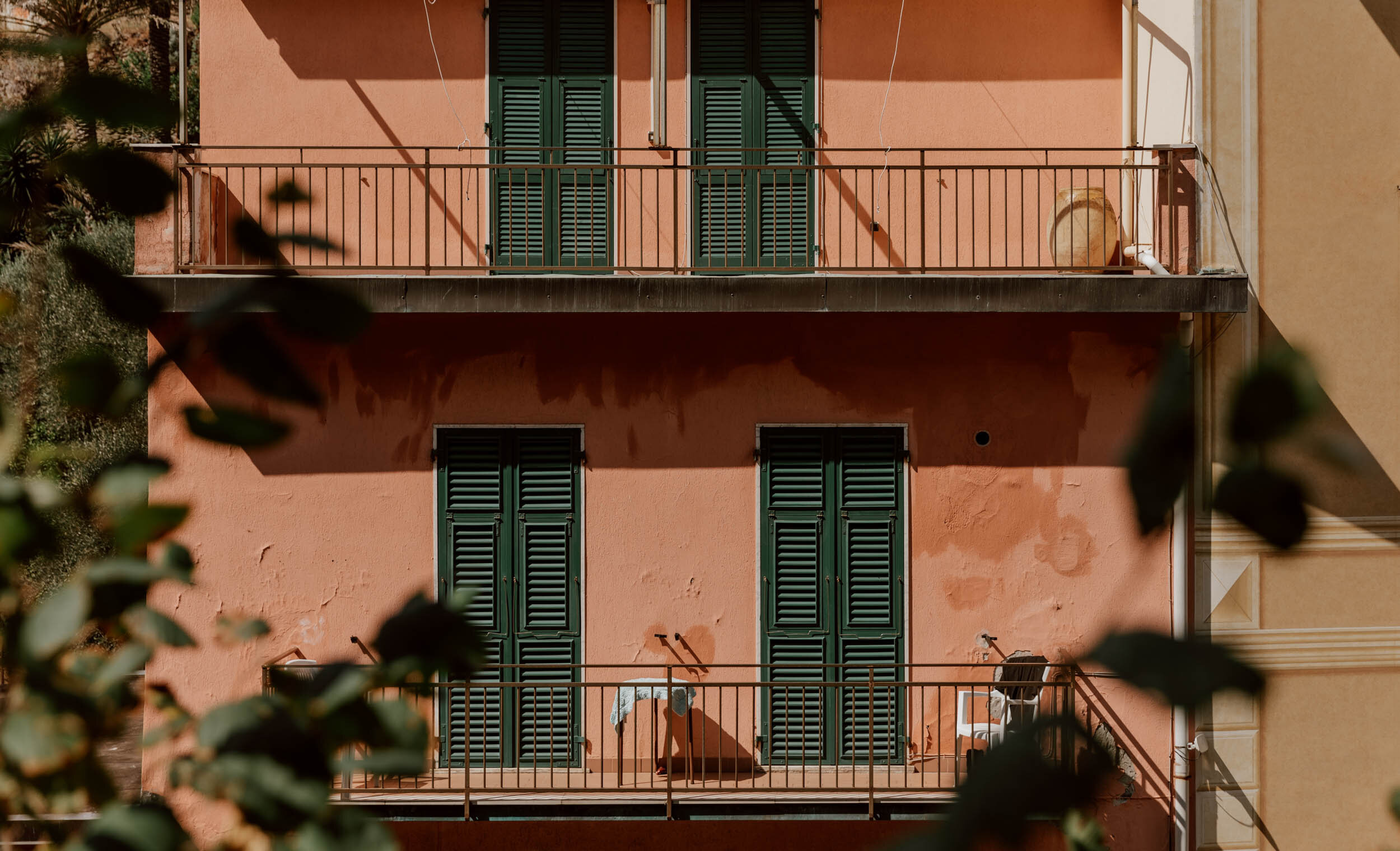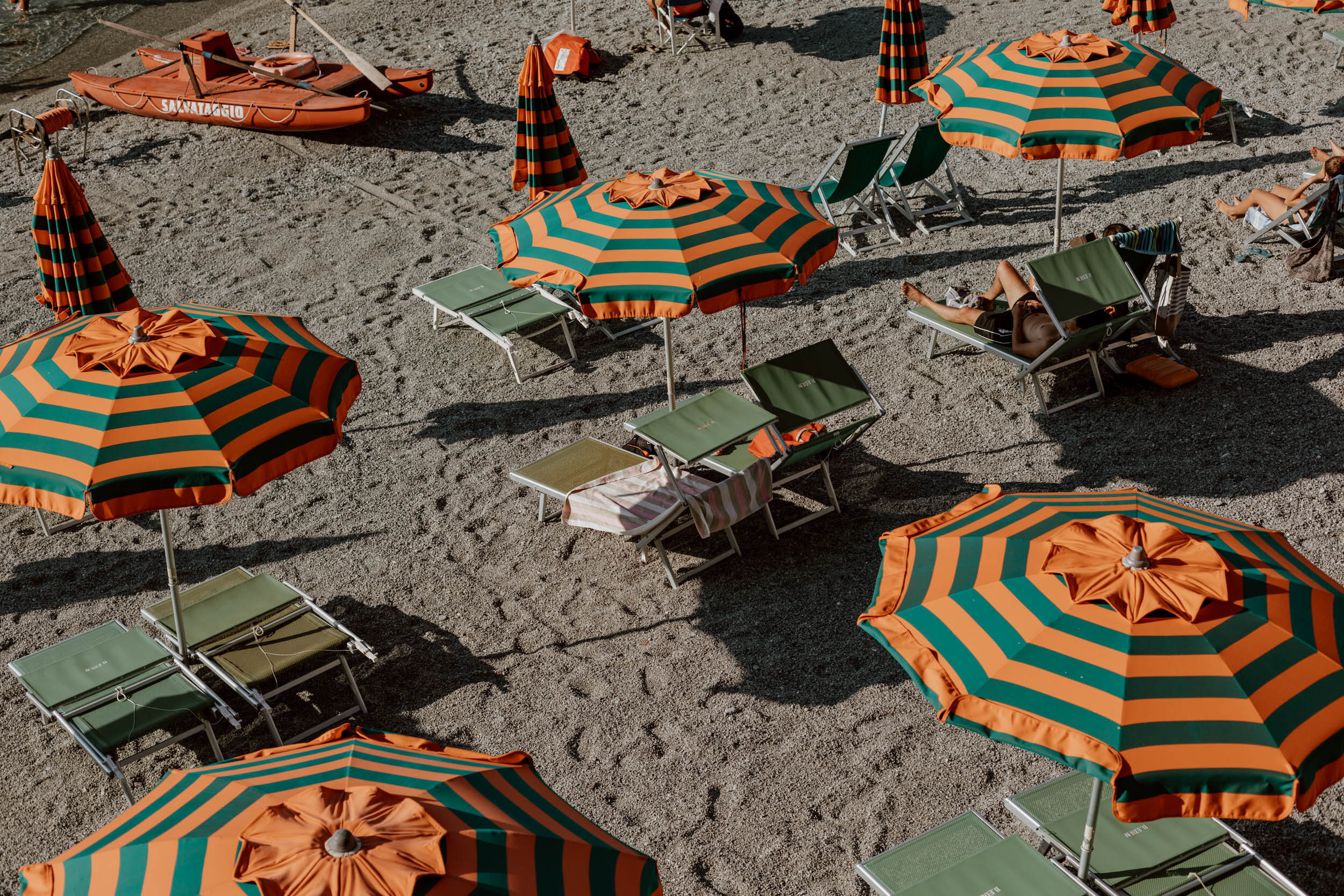Looking out upon those famous pastel rainbow houses tumbling toward the sea at sunset was a dream for both of us, and we achieved it during a wonderful week in summer 2020. Although smaller than most people imagine, the Cinque Terre offered us a sweet, concentrated version of those quintessential moments of Mediterranean happiness a traveller daydreams over: lazing by the warm water, dining out on fresh locally caught seafood, sweating on a dusty hill trail alongside ancient vineyards, and lashings of la dolce vita vibes to savour.
A destination as popular with hikers as it is with sunbathers and Italophiles, Cinque Terre’s popularity and unique layout between the cliffs and the sea does however make it necessary to do a little bit of ground work before you arrive in this irresistible colourful coastal nook of north-west Italy.
In this beginner's guide to the Cinque Terre, we've shared all the essential things we think you need to know to plan the very best visit to one of Italy's most famous destinations. From practical advice on choosing where to stay, transport connections, and avoiding the crowds, to more fun things like where to find the best sunbathing spots, our favourite viewpoints, and unmissable regional foods to try, we've got you covered to ensure you also have a wonderful Cinque Terre experience.
These are 23 essential things to know before visiting the Cinque Terre.
the essentials
// UNESCO World Heritage site composed of five isolated coastal villages in northern Italy
// Famous for seafood, wine, and colourful buildings.
// Primarily a summer location for sunbathing and la dolce vita, but also great hiking
// Very large high season crowds and, unfortunately, cruise ship groups
// Best accessed via a regular train service or on foot.
23 Things to Know Before Visiting the Cinque Terre
What Is The Cinque Terre National Park
There is not one single village or town called 'Cinque Terre', but that's not an uncommon misconception.
You're actually going to be visiting Italy's first national park - Parco Nazionale delle Cinque Terre. Designated in 1999, the relatively small 15 square mile area is comprised of five colourful villages (more detail on those later), as well as rugged cliffs, bays, and coves along the Ligurian coast, agricultural land, and a protected marine area.
So, although you're going to 'Cinque Terre', there are actually a myriad of ways that you can experience the national park - and that, alongside its fame, is why you'll find French people in hiking boots, bikini-clad sun-worshippers, photographers and large tourist groups, and honeymooners looking for romantic evenings all within a few miles of each other.
How To Say It Right
Most of us non-Italian speakers will likely be saying it in a garbled blend of 'sinky terry', 'sank ter', or 'chink tar' before arriving (we most certainly did).
The correct pronunciation of Cinque Terre, which means ‘five lands’, is CHEEN-kweh TER-ray.
Now, there may be some further disagreement from phoneticians or linguists, but say it like that and you'll be as near as damn it!
The Five Cinque Terre Villages Are Beautiful
If you’ve been inspired to visit this region by a photo on social media, then we’ll put good money on the fact that it involves a tight cluster of rainbow houses tumbling down a cliffside toward the sea?
Thought so.
The romantic draw of such a beautiful scene is clear, particularly if you've craving an idyllic Italian summer experience, but each of these medieval villages also represents the interaction of man and the landscape to co-exist and shape eachother's destinies. When you get past the colourful aesthetics, the Cinque Terre's villages are quite unfathomable, bold settlements by the sea, built in defiance yet in harmony with the obstacles presented by nature. For centuries, they were only accessible by trail or boat.
Without the colour, they would still be captivating; with it, they are astounding.
There are several stories surrounding why the palette of the Cinque Terre villages is so colourful and, similar to the island of Burano, they largely revolve around fishermen painting to make them easier to spot from the sea (although others say that it was tarted up in the 70s for tourism).
When planning, the five may seem relatively indistinguishable given that they’re all so small (each populated by less than a couple of thousand or so permanent residents), have a similar layout of steep, narrow alleyways by the sea, and all are beautiful - the reality is that there are a few notable differences to be aware of in advance which will shape your experience. We have created specific guides to each Cinque Terre village, which give you more of an idea on the charms, personality, and amenities of each alongside tips for enjoying them, our personal favourites, and the best accommodation options, but what you need to know in a nutshell is:
Monterosso al Mare | The largest and northernmost of the five, split across an older and a newer section separated by a tunnel. It's home to several popular lidos, the beaches, a relatively large slection of restaurants and has the most holiday resort set-up (albeit on a very small scale).
Vernazza | It suffered the most damage from the devastating floods of October 2011, but the reconstruction has been graceful and not harmed its traditional aesthetic. A pretty and popular base town with a bustling port area to eat, drink, socialise, and sunbathe.
Corniglia | The 300 or so steps which climb from the train station to this clifftop village, the smallest of the five, is perhaps the only reason for Corniglia being a less popular option for overnight stays - but the village itself is an absolute gem with great places to eat and swim.
Manarola | With a selection of good restaurants, an accessible sunbathing harbour, plenty of accommodation and a glorious sunset viewpoint, Manarola is a popular base or day-trip visit.
Riomaggiore | The second largest and southernmost village offers up quintessential Cinque Terre vibes with a more youthful atmosphere and easy access to the water. There are more activities, tours, and viewpoints on offer here than the other villages, so we were really happy to have based ourselves there for the second half of our week.
We also think it’s necessary to point out here, given that quite a few people mix them up given the understandable similarities in appearance and vibe, that the Amalfi Coast and Cinque Terre are NOT the same place; the Amalfi Coast is much further south, close to Naples and Pompeii.
Also, Cinque Terre isn’t a late-night party or booze location, and you shouldn’t come here if that’s what you’re looking for.
How To Get To the Cinque Terre
What airport do you fly into for Cinque Terre? Your best options are Pisa and Genoa airports, with Florence and Milan also viable; from any of these airports or city centres, you can connect and hop on a train toward the coast. We’ve written specific step-by-step instructions below:
// How to get from Pisa to Cinque Terre
// How to get from Genoa to Cinque Terre
// How to get from Milan to Cinque Terre
// How to get from Florence to Cinque Terre
Trains to the Cinque Terre from these cities, as well as others in northern Italy, are frequent and you don’t need to pay more for the slightly faster Frecciarossa high-speed trains. Typical travel times are:
Pisa + Genoa | 90 mins
Lucca | 2 hours
Florence | 2.5 - 3 hours
Milan | 3.5 hours
Verona | 4-5 hours
Venice | 5-6 hours
Rome | 5-6 hours
To find schedules and book tickets in advance, checkout Trenitalia or Italiarail.
It's also possible to arrive by car, but we strongly suggest that you...
Leave The Car Behind
We're big fans of road trips in Italy, and that's how we've explored Sicily, Puglia, and the Dolomites in the last few years.
However, for Cinque Terre, you really should just leave the rental car behind.
That the majority of the villages can only be accessed by narrow, steep, winding mountains roads should be enough to make you think twice, but that they’re also largely closed to all traffic, except locals, should settle all debate.
A car is so inessential to the Cinque Terre experience that having one with you for a few days will simply prove to be an expensive impediment to your enjoyment. There's a decent-sized parking area in Monterosso (the new part) and there is parking just outside some of the other villages, but it's costly, limited, and in high demand from locals.
You simply do not need a car here.
So, if you are doing a Tusacan or north Italy road trip and looking to include the Cinque Terre, our advice is to only stay in Monterosso, base yourself in a nearby town (see below for advice), or find a long-stay car park and stomach the cost so you can leave the car there and stay within the Cinque Terre for a few nights, using the train and your own two feet as your transport.
Travel Tip | If you are renting a car in Italy, then be sure to read our 9 Essential Car Rental Tips for Travellers before booking anything - it’s guaranteed to save you money.
Understand The Cinque Terre Express Train
As we've mentioned above, the train is the best mode of transport to get to Cinque Terre, as well as to travel between the five villages.
You'll see lots of signs and information about the Cinque Terre Express (sometimes referred to as the 5Terre Express) before you visit, and we had assumed it would be a sort of over-priced novelty train just for ferrying tourists from place to place.
The reality is that it's just the regular TrenItalia train, but with marketing and specific ticket conditions in operation from Levanto to La Spezia, the two towns which bookend the five villages. It's frequent, convenient, and covers all the stops within the Cinque Terre National Park, costing €4 for any journey within it (€2 for kids aged 4 to to under 12 years old).
Sounds like pretty good value, no? Not really. The catch is when you realise just how short the distances and travel times are between all the stops. From north to south, the stops and stations are:
Levanto to Monterosso (7 minutes) - Monterosso to Vernazza (4 minutes) - Vernazza to Corniglia (4 minutes) - Corniglia to Manarola (4 minutes) - Manarola to Riomaggiore (3 minutes) - Riomaggiore to La Spezia (8 minutes)
So, if you're travelling three minutes from Riomaggiore to Manarola, that's €4. If you cover the length of it, that's €4. You can see how costs could mount up for not going very far at all...
The positive news for day-trippers, or those who want to use the train several times in a single day, is that you can get unlimited travel on the Cinque Terre Express with the Cinque Terre Card. It costs €16, and you can find all the information on what else it includes, and where to buy it, later in this post.
Travel Tip | You can buy your train tickets at machines or staffed counters in all the train stations, but expect long queues anytime after early morning. A single ticket is only valid for one direct trip, and you can't reserve a seat. Keep an eye out for pickpockets when busy, a common issue on the line. As with all Regionale train journeys in Italy, always validate your ticket before boarding or risk a heavy fine. Find out more in our essential tips for train travel in Italy.
Pack Light, Expect Lots of Stairs
You will thank us for this later, trust me.
Due to the cliffside nature of the villages and the topography of the Cinque Terre, it's best to expect that your accommodation will be located up a few stairs.
Or quite a lot.
Throw in the fact that a few of the train stations involve a mountain of stairs to enter/exit, and it should be clear why packing everything and the kitchen sink into a massive suitcase is not a good idea.
As we were travelling in Italy for seven weeks, this was an issue we couldn't really circumvent - and that may be the (suit)case for some of you too. If so, then we'd recommend ensuring that one of you is at least capable and happy to lug the cases to/from the accommodation on arrival and departure - help or assistance won't be given and shouldn't be expected.
For those of you visiting Italy for a shorter period, then it's best to pack a little less and/or make sure you're able to cart your luggage up the stairs.
The issue of the accommodation and stairs does mean that Cinque Terre is not the most wheelchair-friendly destination, and people with limited mobility or health issues should try to book accommodation which is specifically easier to access. If lots of stairs are going to be an issue, we have made a note of which villages and hotels are best for you in our Where To Stay in the Cinque Terre post.
How Long Do You Need in The Cinque Terre?
We stayed within the national park for six nights, and that was a great amount of time to have a beach day in Monterosso, a full day hiking the Blue Trail, and a few more days to slowly savour the beauty of each of the villages.
However, we know that we were incredibly fortunate to have that amount of time in the Cinque Terre.
We'd recommend a minimum of three nights, four days to make the most of being here (with and without the crowds). Less than that is of course not to be looked down upon, but you will have to pick and choose between activities and time for exploration vs. relaxation.
Some of you may be reading this and thinking about a Cinque Terre day trip. Honestly, we just don't think it would be worth doing and would only add to the unfortunate overtourism which the area has suffered from in the last decade or so. Whilst it's absolutely feasible to travel independently to the area from other popular Italian destinations or take one of several tours, hop and off the Cinque Terre Express to get photos, eat lunch, and have a quick dip, you will be missing out. Also, the atmosphere of each village is transformed once all day-trippers and tour groups have departed.
If you dream of visiting the Cinque Terre, then try your best to give yourself a few nights to actually enjoy it.
Read Later | 13 Wonderful Things to Do in Cinque Terre
You Can Base Yourself Across The Five Villages...
The main planning challenge for Cinque Terre, once you've worked out how many days you can have or can afford, is the question of where to stay.
As mentioned, each of the five villages has their own charms as well as accommodation for all budgets, so there's really no wrong choice; however, we know that some of you with a certain travel style will probably prefer one over another.
If you're here for a two to four nights, we recommend basing yourself in just one village and using it as your base to explore by train and on foot. If you're planning on a longer visit, then it's not a bad idea at all to consider basing yourself across two villages but it isn’t essential - you simply need to try and align check-out/in times and luggage storage, which may be more hassle than it's worth in high season.
We chose to do three nights in Monterosso al Mare followed by three in Riomaggiore.
...Or In A Few Nearby Cinque Terre Towns
The port city of La Spezia to the east and little Levanto to the west offer up two alternative base towns for your time on the Ligurian Coast. Both have better value accommodation and less strain on availability, as well as train travel included within the Cinque Terre Express network.
For the avoidance of doubt though, both of these towns are not part of the actual 'Cinque Terre' (although the national park area does touch upon them).
The downside here is, well, is that really how you want to experience the Cinque Terre? La Spezia is one of the busiest cruise ship docking points in Europe, acting as an access point for the large groups to go to Florence, Lucca, Pisa, or the five villages for the day, so that would be enough to make us reconsider.
However, we do fully appreciate that it may be the only affordable or available option for you.
Want to find out our favourite village to stay in and our personal picks of the best accommodation in each? Check out Where To Stay in the Cinque Terre for all the details.
Book Your Accommodation Now. Seriously.
As the Cinque Terre increases in popularity each year, particularly influenced by its fame on social media, it's become even more important to reserve your accommodation in advance.
There are a finite number of options spread across the five small villages, and the vast majority of travellers will have their eyes set on it - demand usually outstrips supply in the summer season.
So, if you know your dates already, we strongly advise starting to look at booking accommodation sooner rather than later to improve your chances of getting a place that's suitable for your budget, your travel style, and your itinerary.
You can check availability and prices on more than accommodation options within the Cinque Terre National Park on booking.com here or Airbnb here.
However, we know that choosing the right hotel, B&B, guesthouse, or Airbnb involves a lot of work, wasted time and research, so we decided to help you out. Based on our own experiences and research, we've created this Cinque Terre Accommodation guide. It includes our personal picks of the best accommodation options in and nearby the five villages for various budgets and travel styles - hopefully you will find something that's perfect for you!
It’s also important to be aware that many places only allow you to check-in from 3 or 4 pm onwards.
Read Later | The Best Places To Stay in the Cinque Terre
There Are Only Two Beaches
In short, the best beaches in the Cinque Terre are in Monterosso because, well, they're the only 'beaches' in the Cinque Terre!
However, do not despair if you have your heart set on summer fun in the sun.
If you've travelled in Italy a few times before, then your appreciation of what constitutes a beach, and what you need to feel like you're at the beach, are wildly different from the sandy expectations many of us Brits grow up with. Also, you’ll understand exactly how lidos work.
Cinque Terre is tailor-made for days by the sea, and is in fact home to some of our favourite sunbathing spots from that two month trip in Italy and a previous summer spent in Sicily. The difference is that you simply need to adapt and accept that old stone harbours, rocks, and jetties are actually MUCH more fun for sunbathing and swimming!
You can find our favourite spots, alongside where you can find those hypnotically photogenic parasols, in The Best Beaches in Cinque Terre.
The Best Time to Visit the Cinque Terre
As we discuss in more detail later in this post, the Cinque Terre is no off-the-beaten-path hidden gem of a destination; the world and her sisters know about it and everyone dreams of visiting it.
Late May until early or mid-September are always going to be very, very busy. It's July and August that will however see the peak of the high season summer crowd, particularly August when most of Italy is on holiday and prices will spike. Those months are also too damn hot to be enjoyable at times for exploring much on the trails, with temperatures up in the 30s, and cruise ships hordes are at their highest.
Summer weekends also see a lot of locals from the surrounding area or cities arriving for beach days.
We usually visit Italy in September, when the majority of the tourist crowd has been and gone and the temperatures are perfect, and this was the case when we visited Cinque Terre this year. It also coincides with grape harvesting season!
If you are not too fussed about sunbathing or sea-swimming, visit in early spring (April or early May) or push it back until October - perfect times for those who want to avoid crowds, hike more and not sweat buckets, though leaving it late in autumn does increase the risks of rain, mudslides, and trail closures.
We unfortunately can't tell you what it's like in the Cinque Terre in the winter months, but if it's like other coastal towns we've visited in Italy then expect a number of businesses to be closed for the season.
You Can Walk Between The Villages...
A dusty sliver which entwines and entangles between ripening terraced vineyards scattered on steep hillsides, the Cinque Terre's most famous coastal trail deserves a day of your time.
Used for centuries, the Sentiero Azzuro (Blue Trail) links together all five coastal villages, but erosions and landslides - a real problem here - have cut it short the last few years. This meant our only stops were the roll-off-the-tongue triumvirate of Monterosso, Vernazza, and Corniglia.
The plan was to hike all the way to Corniglia (7.6 kms), then do it all again in reverse. Alas, an overly long lunch, a spontaneous swim, and an all too swift sunbathing session on warm concrete, got in the way. Soaked in sweat and the salty sea, we ran to take a two-minute train back to Vernazza to save a bit of time and allow us to walk the last leg back in a golden hour glow.
We sweated a LOT that day.
However, we adore hiking when we travel, and walking the steep ups and downs of the Blue Trail not only delivered an appreciation of the unforgiving terrain upon which these beautiful villages and vineyards were created, but unrivalled views over the sea and the colourful clusters built into the cliffside.
You can find out more about the Blue Trail and how to do it in our Beginner’s Guide to Hiking in Cinque Terre.
Note that the the 1km Via Dell'Amore (Lovers' Lane) path connecting Riomaggiore and Manarola, so called as it was a meeting place for romantic get-togethers of locals, was formerly a very easy, popular part of Blue Trail. It has been closed off for over a decade due to those landslides rendering it inaccessible and unsafe. It's slated to reopen in 2023 at great expense, but we wouldn't hold our breath on that...
Travel Tip | We had no idea before we visited that the Cinque Terre, beyond the Blue Trail, was such a popular destination for proper walkers and hikers. Indeed, there are over 120 kms of trails along its coast line, with about 48 official trail routes. These are completely free to access, and far less congested than the Blue Trail - discovering a few of these is the main reason we’re hoping to return one day. You can find much more information and resources about these trails, and safe, responsible hiking tips for the national park, in our Hiking in Cinque Terre post.
...But You'll Need The Cinque Terre Card!
Do you need a permit for Cinque Terre? No. You will however require the Cinque Terre Card to access the Blue Trail hike.
It took us a wee bit of research before we fully understood the features and benefits of the Cinque Terre card, and whether it was actually required to have one. So, to save you a lot of time, here's the lowdown:
// You need the card to access the Blue Trail, but it is not currently required for the network of other trails within the Cinque Terre National Park.
// There are two variants, the 'trekking card' and the 'treno card',
// The 'trekking card' costs € 7.50 (1 day for adults) or €14.50 (2 days for adults).
// The 'treno card' version of the Cinque Terre Card offers the same access as the 'trekking' one, but includes unlimited second-class train travel within the Cinque Terre Express stations.
// The 'treno card' can be purchased for 1 day (€16 adults), 2 days (€29), or 3 days (€41).
// Both cards are available cheaper for concessions (i.e. over 70s and children aged 4 to under 12) and families (classified as 2 adults with 2 children aged 4 to under 12).
// The Cinque Terre Card can be purchased in advance online here, at tourist information offices located in or outside each of the train stations on the Cinque Terre Express network. You can also buy the Cinque Terre Card at the rail ticket desk inside the stations, but only the 'treno' version.
// It's also possible to purchase the card at the Blue Trail hike checkpoints as you leave or enter a village.
// Day cards are only valid until midnight on the day of purchase / first validation, not for 24 hour periods. Write your name on it once purchased as you may be asked to show it with a valid ID if there's a ticket inspector.
// Both versions of the Cinque Terre Card entitle you to free wi-fi, free use of paid toilets, free use of the ATC bus network between villages, and reduced entry to civic museums in La Spezia.
In short, it's 100% necessary to buy a version of the card if you want to do the most popular hike in Cinque Terre. As we only took one train journey (Corniglia - Vernazza) on our day on the Blue Trail, it wasn't cost effective to buy the 'treno' version and we went for the cheaper 'trekking card'. However, the Cinque Terre Card will save you money overall if you plan on doing that hike one-way and taking three or more trains on the same day.
Away from hiking concerns, the Cinque Terre Card will always save you money overall if you plan on taking more than four train journeys in a single day, and is therefore a sensible purchase you're only going to be in the area for 1-2 days and want to visit all the villages.
Being A Responsible Visitor Is Vital
There are certain rules and responsibilities for any traveller taking on the Blue Trail, but it's also worth reiterating at this stage just how important it is for all visitors to the Cinque Terre to respect the fragility of this destination and the pressures it's under due to a rapid, significant increase in visitor numbers.
With the total permanent population numbering less than couple thousand, the ratio of locals to visitors is quite frankly insane.
Here are some of the positive things you can do to reduce your impact, leave no trace, and help the Cinque Terre maintain a sustainable balance as a destination and a home:
// Wear appropriate shoes on the trails. Flip-flops or open-toed sandals are specifically banned after so many silly people who shouldn't have been on the trail had to be rescued at great cost.
// Do not fly a drone. There are lots of signs up about this dude, don't be a dick and flout them (also, if you see someone hiding behind a rock breaking the clear 'no drone' rules, then feel free to give them a polite, then a stern ticking off like we had to several times). An official permit is required if you do wish to fly yours.
// Try to visit for a few days, rather than a day trip, and spend your money within the local economy.
// Leave the grapes alone! With thousands of visitors each day, if everyone thinks it's acceptable to pick a grape or two from the vineyards, you can imagine just how quickly that could really affect the winemakers and their production here. Same goes for citrus fruit.
// Don't walk around the villages in your swimwear or towels.
// Camping is forbidden everywhere within the park area.
// Limit your consumption of single-use plastic by brining a refillable water bottle, and filling up at your accommodation and / or free fountains in the villages. Monterosso also has a paid for refill station. Find out more in How To Use Less Plastic When Travelling.
// Respect the privacy and property of locals - there are clear 'Private' or 'No Trespass' signs on the trails and off little alleyways in the villages and these are there for a clear reason - to keep tourists out!
The more of us who follow these simple rules or responsible travel approaches, the greater the impact.
You'll Start To Love Anchovies
One half of Along Dusty Roads always associated anchovies with the Teenage Mutant Ninja Turtles, specifically his incredulity that they would order them as a pizza topping.
After our week in Cinque Terre, he has finally come round to the idea.
There is, understandably, a lot fresh seafood on every menu in the Ligurian Coast, but it's the anchovy (alici or acciughe in Italian) which became a staple of our lunches or for a quick snack on the rocks. Monterosso al Mare, the largest of the five villages, is renowned across Italy for its anchovies - there's even an annual Anchovies Festival here in June. You'll see them, as well as other locally caught seafood, on most menus as well as served up freshly fried or in several pasta dishes - we recommend you all to go for the fried ones, heavy on the salt and local lemon, and pair them with a nice local white wine.
In terms of eating out in high season, expect a wait for a table outside at a popular restaurant for lunch or dinner. If you have your heart set on a particular restaurant in particular in the evening, then try to reserve in advance. Food options within the park revolve largely around regional staples, including seafood and pesto dishes, but veggies and vegans will always be able to find a simple pasta dish available on every menu.
You Have To Try Cinque Terre Wine
Although proximity to the sea may make one assume that fishing was always the go-to industry here (before tourism arrived), agriculture has arguably played a more important role in shaping the region. Those terraced vineyards which form such a fundamental part of the Cinque Terre landscape are not just for show - they are productive and integral to the integrity and preservation of the villages. After all, it was sweat and soil of farmer’s who carved out most of the trails we are able to walk between and around the villages.
Used to seeing highly cultivated vineyards elsewhere in the world, to us, the sea-facing vineyards of Cinque Terre have a much more organic, rustic feel. Indeed, winemaking here is defined as a somewhat heroic viticulture because of how difficult it is to work with the improbably steep and awkward rocky terrain, meaning that everything from general maintenance to harvesting needs to be done by hand and some basic monorail machinery. Most winemakers here do it on a very small scale, with grapes stored and wine fermented in hidden away cellars on the backstreets.
There are two main local wines: the Cinque Terre DOC (a dry white made with the native Bosco grape, together with Albarola and Vermentino) and the Sciacchetrà DOC (a sweet fortified dessert wine of which only a few thousand bottles are produced annually by less than two dozen vintners) - and we encourage you to try both during your time in the region. A glass is affordable (€4+) and you’ll always find something local on menus at restaurants and bars, but those who are passionate about wine should make time for a few enotecas too.
Travel Tip | The wine terraces and the old handbuilt dry stone walls which are essential the fabric of Cinque Terre are under threat from various influences: tourism, money, lack of interest, landslides, and a younger generation seeking work in more profitable, less physically demanding trades. We donated to the Grapes & Heroes fundraising project last year, which was set up to specifically raise awareness of these issues and help local vintners maintain and restore the walls which are falling quicker than they can be replaced. Due to this, we were fortunate enough to meet Riccardo, a local vintner during our week, to visit his vineyards high in the hills and sample his wines back at his cellar in on a backstreet in Riomaggiore. The brand is I Magnati, and you can find it available to order at several places we feature in our Riomaggiore guide.
Expect Crowds & Cinque Terre Overtourism
It's incredibly important to appreciate and anticipate that a visit to Cinque Terre means you're going to one of the most popular summertime destinations in Italy - and the cruise ships know about it.
Our pictures in this post are intentionally curated to showcase the idealistic beauty of Cinque Terre, and we were fortunate to visit during the lowest period of tourism it has seen in decades this summer, but it was still pretty busy (at a pleasant level, we must add). It would be disingenuous of us as travellers though to only talk about pretty colourful buildings, swimming spots, and anchovies, and not let you know about the overtourism has become synonymous with Cinque Terre in recent years (à la Venice to the east).
It’s actually the main reason we hadn’t visited it until last summer.
The simple truth is that these historically rural villages, their narrow streets and the dusty trails which link them were built for hundreds of people, not thousands upon thousands. However, there were around two and a half million visitors here a couple of years ago and, if it weren't for the shutdown of global travel last year, this would have continued to rise inexorably. The cruise ships alone, which dock at nearby La Spezia, were slated to increase their passenger numbers to just over a million visiting here in 2020 before the shit hit the fan globally, a staggering 53% rise on 2019.
There are local grassroots efforts to limit numbers and / or increase restrictions, alongside those proposed by local government and the Park authorities, but it's an on-going uphill battle. Crucially, Cinque Terre needs its residents to thrive and remain, not just for the sake of making these villages viable but to preserve the fragile coastline and agricultural traditions of the hills.
For the avoidance of doubt though, there are presently no restrictions or daily limits on visitors to the Cinque Terre; the Cinque Terre card system only relates to regulating access to the one hiking trail.
We are not writing this point to make you despondent for your trip, simply to prepare you for the reality which you'll potentially encounter. Here are a few tips you can use to avoid crowds and lessen strain on the destination:
// Get up earlier - beat the day-trippers, cruise shippers, and those who want a lie-in.
// Travel in off-season.
// Hike the other trails which link the villages, not just the Blue Trail.
// Whilst the cruise industry is in a state of flux this won't present as much of an issue for you, but if avoiding the worst of the cruise ships crowds is important, then it's worth taking at look at the La Spezia port schedule on a site like CruiseMapper or AvoidCrowds and planning around it.
// Stay within the five villages to enjoy them in the early morning and evenings, rather than depending on the train to take you and everyone else in from La Spezia or Levanto. The atmosphere really does change quite a bit between the peak afternoon and evening once day-trippers leave, so it allows you to appreciate the village in a much better light.
The Sunset Views Are STUNNING
Whether it's from the rocks of Riomaggiore, the viewpoint facing Manarola, or from the dusty trail overlooking Vernazza, sunsets in the Cinque Terre are made to be savoured.
Do your best to enjoy at least one during your stay with friends, a lover, or a solitary beer.
We’ve shared tips on where to find our favourites within the individual village guides.
Head Out On A Boat Trip
Speaking of views…
An alternative way to a fresh perspective of the villages and excellent views of the Ligurian coastline is to head out on a boat trip.
Serving Monterosso, Vernazza, Manarole, Riomaggiore, as well as La Spezia, Portovenere and Levanto, this daily Cinque Terre ferry service provides a more scenic way to go from village to village than the train. You can opt for an all day ticket in order to go between all or most of the stops and hop on/off to make a full day of it, or you can simply use it as a means of going from one village to another, though this is more expensive and inconvenient than the train. Similarly, taking the boat may increase your stress levels as you have to walk and explore and be back in the queue to board according to their schedule, rather than the much more frequent train - in the heat of July and August this may remove much of the pleasant experience you may be picturing right now…
Note that clifftop Corniglia is not included as a stop.
The ferry runs from 1st April to 1st November, with increased departures in the summer season. A day ticket is €35 per adult, €20 per child, slightly cheaper if you are not including Portovenere or only travelling in the afternoon, whilst a one-way journey ticket varies quite dramatically (€7-20) depending on start/end point. Tickets are sold first come first served on the day at the respective harbours, and cannot be reserved in advance at present.
For the best views, consider your direction of travel and try to get a seat on the side of the boat which looks out onto the coast!
A much more enjoyable way to head out to sea would be a on a private or group boat trip for a few hours, which usually includes drinks, a swimming stop, and sunset views back over the coast; this is a sunset boat tour option you can book in advance.
You can also considering renting your own boat (depending on your abilities) or take a kayak out for a few hours (there’s also this highly-rated guided kayak tour).
It Can Be Done On A Budget (Sort Of)
The beauty of Cinque Terre can indeed be enjoyed on a bit of a budget - most of the trails are free, it doesn't cost anything to access the villages themselves, the sea is open to everyone, transport is affordable if you plan ahead, and you can have some lovely lunch/dinners for less than €10 - but it's certainly not the cheapest coastal destination to choose in Italy.
If you are on a tighter budget, it's the accommodation which should cause the biggest concern - and that's just another reason why it's so important to get it booked early (see our accommodation post here).
We've shared typical travel expenses and costs in the Cinque Terre to help you plan your own budget - check out What Things Cost in the Cinque Terre (published soon).
You Will Love It
In these guides, our job is to provide you with inspiration and ideas, alongside a realistic take on what to expect in a destination and tips for enjoying it responsibly. Sometimes that means we may strike a slightly cynical or negative note, but hopefully you appreciate why it’s important to not simply give you meaningless holiday brochure blurbs (and as you’re reading our travel blog, it’s probably not the information you want either!).
We savoured that week in the Cinque Terre, from sweating buckets on the dusty trails and the endless steps to our accommodation, to lazing at the crowded lido, drinking local white wine by the bottle, watching iconic golden sunsets, exploring backstreets, eating the delicious seafood, and the unexpected little moments in between it all. If visiting during peak summer season with the usual crowds, that enjoyment would certainly have been hampered to some extent, but we’re confident that we would still have been able to carve out a really enjoyable time in the Cinque Terre too.
We truly hope you’ll love it half as much as we did.
For more advice and inspiration for your own Cinque Terre experience, be sure to take a look at our guide series below.
Your Next Stop
13 Wonderful Things to Do in the Cinque Terre
Cinque Terre Village Guides | Monterosso, Vernazza, Corniglia, Manarola and Riomaggiore
Where to Stay in the Cinque Terre
A Beginner’s Guide to Hiking in the Cinque Terre
Where To Find The Best Cinque Terre Beaches
10 Things to Know Before You Visit Italy

